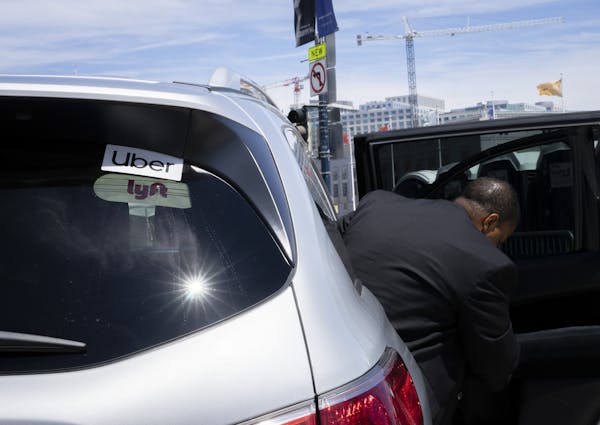The drivers of Edina are not happy.
"Ridiculous," "odd," "absurd" and "confusing and dangerous" are just a few of the descriptions irate drivers have used in e-mails to city officials about the weird bike lanes that have popped up around the city this fall.
If Edina drivers think the lanes are unusual, they're right. The city is believed to be just the second in North America, behind Minneapolis, to be experimenting with "advisory" bike lanes. Richfield will become the third next spring.
The lanes are one of the experiments that stem from a $28 million federal grant to boost biking and walking in the Twin Cities. Steve Clark of Transit for Livable Communities, which is administering the grant, said the advisory bike lane pilots are being watched nationally.
"These are very common in Europe," said Clark, who manages walking and biking programs for TLC. "My sense is a place like Edina is ideal in that they are a very open, democratic community. ... Anytime you get a community talking about the rights and responsibilities of bicyclists and motorists, that will increase awareness."
But, he conceded, "when people see something different, it can be unsettling."
Unsettling indeed. The advisory bike lanes on Wooddale Avenue, which were installed about a month ago from the intersection of W. 50th Street to Valley View Road, have run into some serious cultural misunderstanding.
"I recently drove down Wooddale ... and it looked like there are only two bike lanes and one car lane? Is this right?" one Edina resident wrote to the city. "Are there really more bikes than cars in Edina?"
Wooddale, which was identified as a primary north-south route in the city's bike plans, has a permanent, marked parking lane on one side to serve homes that face the street. That means the traffic area left on the street is too narrow for two conventional bike lanes and two lanes for motorized vehicles.
That's where the advisory bike lanes came in. Marked with a dashed white line and bike symbol, the idea is that cars can drive in the advisory lanes unless a bicyclist is present. Then, they must yield to the cyclist and wait for oncoming traffic to pass before passing the bicyclist.
Clark said European studies indicate that advisory lanes are safe for bikers and that drivers tend to slow down and be more watchful on such streets. But in Edina, some drivers have been confused and have refused to cross into the dashed bike lanes even when no cyclists are present. With no center line marking on the road, befuddled drivers have sometimes found themselves driving straight at each other.
Yet the only accident so far has been a driver who ran into a parked car.
Edina Mayor Jim Hovland, normally a supporter of adding bike paths and lanes in his city, thinks the city didn't do enough education beforehand to help people understand the change. He said the road markings make it appear that bikes are king on Wooddale and cars are secondary.
"You look at that and you don't know what to do," he said. "People don't want to cross that dashed white line. I worry about older drivers, and visitors. ... It feels unsafe to me."
Can drivers adapt?
For now, giant flashing signs have been added on Wooddale to warn drivers of the change. At a City Council meeting this week, other council members rebuffed Hovland's suggestion to paint a center line on the road again and eliminate the dashed lines. City Engineer Wayne Houle told the council that drivers appear to be "getting it." He said the educational process may not be so different from what happened when the city added roundabouts to some streets.
"Tonight I drove it and I was really impressed," he said. "I recommend we hold the course for now."
In an interview, Houle said one of the complicating issues on Wooddale appears to be that the parking lane on one side of the road isn't always full, so drivers approaching from the other direction assume that oncoming cars can move into the parking lane (they can't).
Clark agreed. In Minneapolis, E. 14th Street downtown also is striped with advisory bike lanes. But because there are parking lanes on both sides of the street and they are almost always full, he said it's obvious to drivers that the bike lanes have to be where they are.
Even on 14th, the transition was not totally smooth. Shaun Murphy, Minneapolis' bike coordinator, said that when the advisory bike lanes were added a year ago, some drivers thought the street had become one-way. Directional signs with arrows indicating two lanes of traffic were added.
Now, he said, "I ride down that street almost daily and see very little confusion. ... I have ridden it hundreds of times and the traffic is calmed. Everyone goes slower and gives you more passing distance."
The advisory lanes will be studied for two years. The changes are being recorded on videotape, and speed and accident rates will be compared.
"I think it's a little too early to say what will happen," Murphy said. "We're learning where they work best, and where they don't by having these in different cities. My hunch is that people will get used to bike lanes in different configurations."
Mary Jane Smetanka • 612-673-7380 Twitter: @smetan
Sen. Nicole Mitchell to be relieved of committee assignments while case under review

Help on the way for north Minneapolis neighborhood prone to extreme flooding
New director of Minneapolis Animal Care and Control is longtime abuse investigator Tony Schendel
Brooklyn Park police make arrest after asking for help in search for man suspected of sexual assault at gunpoint

